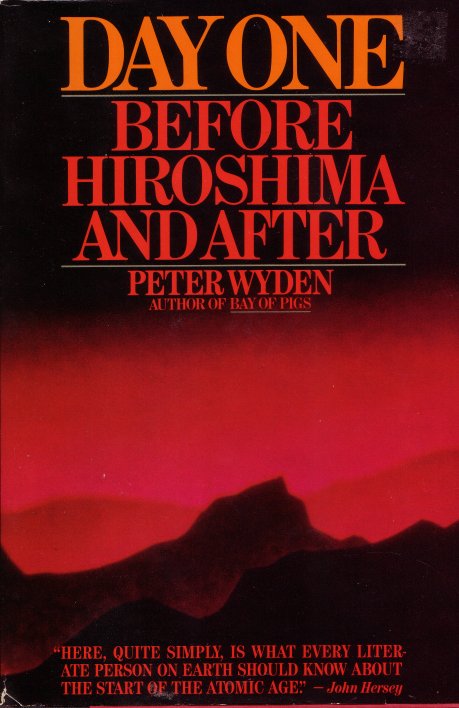
Day One

This book is subtitled Before Hiroshima and After. It is filled with a lot of material on the events leading up to the bombing and events just after the bombing. It's also written in a rather readable style.
The book starts off noting a physicist (the chief scientist on the Tinian forward Air Force base) who had been told that it might take fifty atomic bombs before Japan would be conquered.
Some days after the dropping of the atomic bomb Tokyo Rose announced that radiation injuries and illnesses were affecting many of the survivors of Hiroshima. This came as a surprise to the scientists. The book says that a ranking radiation expert claimed the reports were a hoax.
There was concern that a plane carrying an atomic bomb might crash on takeoff, blowing up the entire island.
Before any bomb was dropped, it was also considered possible that once the bomb exploded the shock waves would destroy the plane.
Major General Groves was Oppenheimer's boss. The book says “He wanted to adminnister the most horrifying possible psychological blow to shock the Japanese into surrendering and that meant he needed maximum casualties.”
Tokyo was briefly considered, but it would be having bad weather when the bomb would be ready to be dropped, and a large part of the city had already been destroyed by the firebombing, so it would make it hard to tell just how effectively the atomic bomb was. For that they needed an almost pristine city.
Kyoto meant the various criteria for being a target city. Yokohama was a possiblity, as was Yawata, but Hiroshima was the largest target that had not yet been on the firebombing list. Kyoto and Hiroshima were the two top targets; Yokohama and Kokura Arsenal were the next level down, and below that was Niigata, which was eventually dropped from the list of possible atomic bomb targets.
Kyoto had many lacquer factories that had been converted to explosives-making plants. Over 26,000,000 square feet of industrial plant area had been identified in aerial photographs. There was also an aircraft engine plant in the area. Hiroshima had various military headquarters, plants for aircraft parts and machine tools, and home factories.
Kyoto received a reprieve, though, when the Secretary of War said he didn't want that city to be a-bombed since it was a city of great religious significance to Japan, and that bombing such a city could cause American to lose “stature” after the war.
Thus, Hiroshima became target 1 by default.
There is an eye-witness account of an American captive being attacked by civilians who were throwing rocks at him. Some other airmen who had ditched (at some other time; not during the atomic bomb dropping) had been picked up by fishermen who were going to behead them, but they were saved by a Japanese military policeman. This is an area I haven't read a lot in, and that is the reaction of the average Japanese civilian to American prisoners, but from what I have read it seems the prisoners were safer in the hands of the Japanese military, or at least no worse off.
The second atomic bomb was destined for Kokura, but because of bad weather the plane went for the secondary target, which was Nagasaki.
A partial timeline can be constructed from the book:
August 6th, 1945: 8:16 a.m.: telephone lines to Hiroshima go dead.
ca. 8:20 a.m. Tokyo railway signal determines loss of telegraph line near Hiroshima.ca. 10 a.m. Osaka Central Command HQ reports military communication with Hiroshima had failed.
Afternoon: editors of various newspapers are called into Information and Intelligence Agency. An army press officer tells them a different type of bomb had been dropped on Hiroshima. No other details were available, and papers were to treat the bombing as being normal.
6 p.m. Radio reports Hiroshima was attacked by B-29s dropping incendiary bombs, and damage was being investigated.
Aug. 7Th, 1945, 1 a.m. Americans broadcasts that an atomic bomb was dropped on Hiroshima were picked up. Government bureaucrats want to minimize the reports of damage.
3:30 p.m. Japanese Imperial HQ says a new type of bomb had been used on Hiroshima the previous day and the matter was still being investigated.
August 8th. Arguments still going on among government bureaucrats as to what everything meant. “Defensive measures” against the bomb were considered, such as wearing light clothing.
August 9th, 11 a.m. Meeting of military leaders where some still expect an actual invasion of Japan, and that the Japanese military could “destroy the major part of an invading force.” The men are told that Nagasaki has been bombed. Afternoon meetings still see deadlock, with many still wanting to continue the fight.
11 p.m. Imperial Conference with the Emperor attending. There was a rumor that Tokyo would be a-bombed on the 12th. The Emperor basically says enough is enough, and that the war was over. (There was nearly a coup after this, though, which could have changed the length of the war but not the result.)
Aug. 15Th: Japan surrenders.
Sept. 8Th: Delegation allowed to go to Hiroshima with medical supplies and to investigate the reports of radiation sickeness.
Sept. 19Th: MacArthur imposes censorship on all media, wanting to shut down the reports of radiation sickness. Some documentary footage filmed by a Japanese was confiscated and held by the US military for twenty-five years.
For at least seven months food and water were in short supply in the bombed cities.
The book also talks about how disfigured survivors of the atomic bombing were treated like outcasts by the Japanese themselves.
Main Index
Japan main page
Japanese-American Internment Camps index page
Japan and World War II index page
|